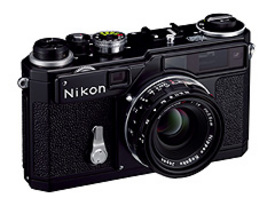Do you care — really care — about expressing your brand as best you can?
The people at Nikon really care. They recently reissued their famed SP 35mm camera from 1957, and it’s incredible the length they went to make this new offering look, feel, and even sound like the brand-defining original.
How incredible? Well, Nikon engineers used computers to create a sonic "fingerprint" of the original and then fine-tuned the materials of the new SP to make it sound exactly the same. For example, rather than using modern titanium for the focal plane shutter, they chose to employ rubberized silk — the way things were circa 1957. This is an expensive design decision, not to be taken lightly. Assembly lines for this kind of shutter are way more expensive to run because the fabric precludes a modular, streamlined production flow, and demands a very tricky fine tuning of each unit. By the way, this is not the sort of thing they teach you at Harvard Business School. Can you imagine standing up in your next marketing meeting and saying "We’re going to go with this production method from the Eisenhower decade because it’s the best thing for our brand. Oh, and it costs a bundle and isn’t technically advanced, either."? It would be tough for me, too.
But it’s absolutely the right choice, because it makes the new SP sound right, and that’s worth everything here. Sound really does matter. How far would you go to make your brand sound the way it needs to sound?
Read Sound Matters & Sound Matters, part 2
thanks to Valentin Sama for the reference


The Konica-Minolta A200 digital camera (8MP, mechanically linked zoom) has an interesting option for its “shutter” sound effect. From the manual:
SHUTTER FX
A shutter sound effect gives positive audio confirmation when the shutter is released. … Two shutter effects are available. Signal 1 uses the shutter sound from the Dynax/Maxxum 9 SLR. Signal 2 uses a mechanical shutter sound taken from the legendary Minolta CLE.
This feature on the KM digital camera obviously doesn’t require anywhere near the monetary investment that Nikon has expended to recreate their classic camera, (the KM, after all, essentially is a computer with a lens, sensor, mic, and speaker attached to it) but interesting that KM uses this classic shutter sound to indicate the operation of a function that doesn’t really exist: this camera doesn’t even have a shutter.
My digital camera (a Canon Powershot G3) has the ability to upload any sound you want for your “shutter”.
Very cool. Still, it’s worth asking how long such sounds will mean anything to users. I vaguely remember my father’s Minolta and Canon SLRs from the 1960s and 1970s, and even as a child I could tell that they were Pieces of Serious Engineering. (The fact that I’d have been killed if I’d touched them unsupervised also contributed to this awareness.)
But in an age when Nokia may be the world’s biggest camera maker, the ability of the old mechanical sounds to signal things like high quality, workmanship, or professional distinctiveness are likely to fade.
Oh, it’s definitely a niche market kind of thing. We’ll see this thing happen more and more with products that appeal to fringe users who care about visceral qualities such as sound, texture, heft, feel, etc… It’s no accident that the new 911 was designed to sound like the original, air-cooled model.
This is definitely not a Prius type of thing.
I am a newcomer to this site, and just wanted to express my appreciation for the attention to details found here. I am a fierce believer (to the chagrin of some of my teachers and peers) of the emotional and visceral qualities of a brand, company, and especially a product. Thank you for such informative and comforting (somebody else thinks like I do!) subjects.
Nicely written, Diego! Thank you for the reference.
Next time you come to visit in Spain we should have a “sound tasting” session: Voigtlaender Bessamatic, Leica II, Exakta Varex VX IIa, Robor Star….
Diego,
Yesterday I heard a quote attributed to John Seely Brown that applies [paraphrasing]: ‘if you want to design an interface that looks good, make it sound good.’ Building on the idea, I know that smell is a sense that is most closely linked to the limbic system/emotions and memory. If you could make this camera smell old (maybe a little ‘oil’ for the hinges), the nostalgia would probably be over the top.
Ryan
I really like the idea of “sound tasting” sessions.
And of making products smell “old”. Excellent.